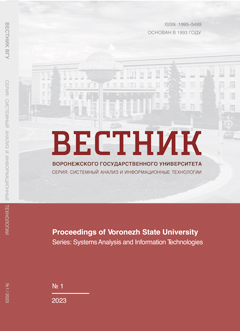Evaluating the performance of support vector machines based on different kernel methods for forecasting air pollutants
Аннотация
The alarming level of air pollution in urban centres is an urgent threat to human health. Its consequences can be measured in terms of health issues experienced by children, an increasing numbers of heart and lung diseases, and, most importantly, the number of pollution related deaths. That is why a lot of attention has recently been paid to air pollution monitoring and prediction modelling. In order to develop prediction models, the study uses Support Vector Machines (SVM) with linear, polynomial, radial base function, normalised polynomial, and Pearson VII function kernels to predict the hourly concentration of pollutants in the air. The paper analyses the monitoring dataset of air pollutants and meteorological parameters as input variable to predict the concentrations of various air pollutants. The prediction performance of the models was assessed by using evaluation metrics, namely the correlation coefficient, root mean squared error, relative absolute error, and relative root squared error. To validate the model, the accuracy of the predictive algorithm was tested against two widely and commonly applied regression approaches called multilayer perceptron and linear regression. Furthermore, back check prediction test was performed to examine the consistency of the models. According to the results, the Pearson VII function and normalised polynomial kernel yield the most accurate results in terms of the correlation coefficient and error values to predict the concentrations of atmospheric pollutants as compared to other SVM kernels and traditional prediction models.
Скачивания
Литература
2. American Lung Association. “The state of the air 2019”. 2019. Available at: URL.
3. Xie Y., Zhao L., Xue J., Hu Q., Xu X., Wang H. A cooperative reduction model for regional air pollution control in China that considers adverse health effects and pollutant reduction costs. Science of the Total Environment. 2016. 573. P. 458–469. Available at: DOI.
4. Brunekreef B. and Holgate S. T. Air pollution and health. The lancet, 2002. 360. P. 1233–1242. Available at: DOI.
5. Gardner M. W. and Dorling S. R. Neural network modelling and prediction of hourly NO2 and NO2 concentrations in urban air in London. Atmospheric Environment. 1999. 33. P. 709–719. Available at: DOI.
6. Holloway J. Legend-tripping in spooky spaces: ghost tourism and infrastructures of enchantment. Environment and Planning D: Society and Space, 2010. 28(4). P. 618–637. Available at: DOI.
7. Bedoui S., Gomri S., Samet H. & Kachouri A. A. Prediction distribution of atmospheric pollutants using support vector machines, discriminant analysis and mapping tools (Case study: Tunisia). Pollution, 2016. 2. P. 11–23.
8. Daly A. and Paolo Z. Air pollution modelling – An overview. Ambient air pollution, 2007. P. 15–28.
9. Cohen A. J., Brauer M., Burnett R. et al. Estimates and 25-year trends of the global burden of disease attributable to ambient air pollution: an analysis of data from the Global Burden of Diseases Study. The Lancet. 2017. 389. P. 1907–1918. Available at: DOI.
10. Lelieveld J., Evans J. S., Fnais M. et al. The contribution of outdoor air pollution sources to premature mortality on a global scale. Nature. 2015. 525. P. 367. Available from: DOI.
11. Pannullo F., Lee D., Neal L., Dalvi M., Agnew P., O’Connor F. M., Mukhopadhyay S., Sahu S., Sarran C. Quantifying the impact of current and future concentrations of air pollutants on respiratory disease risk in England. Environ. Health, 2017. 16. P. 29. Available at: DOI.
12. Kinney P. L. Climate change, air quality, and human health. American journal of preventive medicine. 2008. 35. P. 459–467. Available at: DOI.
13. Jiménez P. A. and Dudhia J. On the ability of the WRF model to reproduce the surface wind direction over complex terrain. J. Appl. Meteorol. Climatol. 2013. 52. P. 1610–1617. Available at: DOI.
14. Ritter M., Müller M. D., Tsai M. Y., Parlow E. Air pollution modelling over very complex terrain: An evaluation of WRF-Chem over Switzerland for two 1-year periods. Atmos. Res. 2013. 132. P. 209–222. Available at: DOI.
15. Masih A. Machine learning algorithms in air quality modelling. Global Journal of Environmental Science and Management. 2019. 5(4). P. 515–534.
16. Rahimi A. Short-term prediction of NO 2 and NOx concentrations using multilayer perceptron neural network: a case study of Tabriz, Iran. Ecological Processes. 2017. 6(1). P. 4. Available at: DOI.
17. Yu R., Yang Y., Yang L., Han G., Move O. Raq--a random forest approach for predicting air quality in urban sensing systems. Sensors. 2016. 16. P. 86. Available at: DOI.
18. Wang W., Men C., & Lu, W. Online prediction model based on support vector machine. Neurocomputing. 2008. 71. P. 550-558. Available at: DOI.
19. Grivas G., & Chaloulakou A. Artificial neural network models for prediction of PM10 hourly concentrations, in the Greater Area of Athens, Greece. Atmospheric environment. 2006. 40. P. 1216–1229. Available at: DOI.
20. Masih A. Application of ensemble learning techniques to model the atmospheric concentration of SO2. Global Journal of Environmental Science and Management. 2019. 5(3). P. 309–318.
21. Jiang N., & Riley M. L. Exploring the utility of the random forest method for forecasting ozone pollution in SYDNEY. Journal of Environment Protection and Sustainable Development. 2015. V. 1. P. 245–254.
22. Elangasinghe M. A., Singhal N., Dirks K. N., Salmond J. A., Samarasinghe S. Complex time series analysis of PM10 and PM2.5 for a coastal site using artificial neural network modeling and k-means clustering. Atmospheric Environment. 2014. 94. P. 106–116. Available at: DOI.
23. Baawain M. S. & Al-Serihi A. S. Systematic approach for the prediction of ground-level air pollution (around an industrial port) using an artificial neural network. Aerosol and air quality research. 2014. 14. P. 124–134. Available at: DOI.
24. Guo H., Zhao J., Yin J., Yao L. Structural testing of polyimide nanocomposite films with SAXS and SVM-PUK. Polymer Testing. 2018. 70. P. 30–38. Available at: DOI.
25. Liu Zhiliang and Hongbing Xu Kernel parameter selection for support vector machine classification. Journal of Algorithms & Computational Technology. 2014. 8.2. P. 163–177. Available at: DOI.
26. Abakar Khalid A. A. and Chongwen Yu. Performance of SVM based on PUK kernel in comparison to SVM based on RBF kernel in prediction of yarn tenacity. Indian Journal of Fiber and Textile Research. 2014. 39. P. 55–59.
27. Zhang G. and Huihua G. Support vector machine with a Pearson VII function kernel for discriminating halophilic and non-halophilic proteins. Computational biology and chemistry. 2013. 46. P. 16–22. Available at: DOI.
28. Juhos I., Makra, L. and Tóth B. Forecasting of traffic origin NO and NO2 concentrations by Support Vector Machines and neural networks using Principal Component Analysis. Simulation Modeling Practice and Theory. 2008. 16. P. 1488–1502. Available at: DOI.
- Авторы сохраняют за собой авторские права и предоставляют журналу право первой публикации работы, которая по истечении 6 месяцев после публикации автоматически лицензируется на условиях Creative Commons Attribution License , которая позволяет другим распространять данную работу с обязательным сохранением ссылок на авторов оригинальной работы и оригинальную публикацию в этом журнале.
- Авторы имеют право размещать их работу в сети Интернет (например в институтском хранилище или персональном сайте) до и во время процесса рассмотрения ее данным журналом, так как это может привести к продуктивному обсуждению и большему количеству ссылок на данную работу (См. The Effect of Open Access).



















